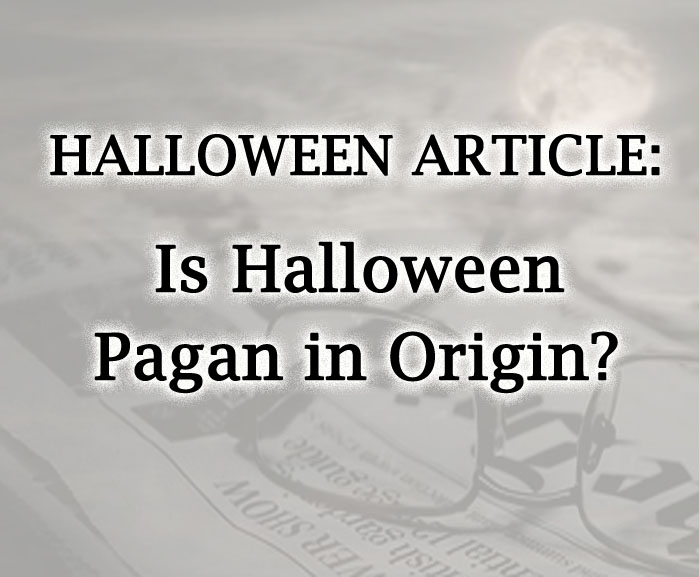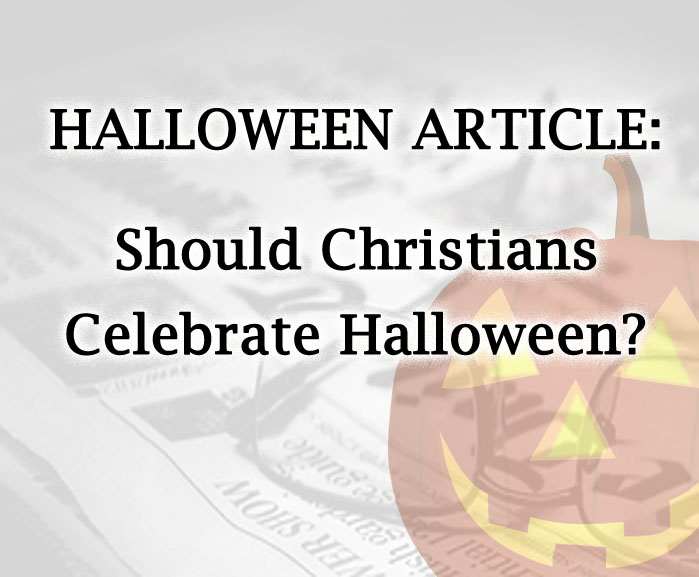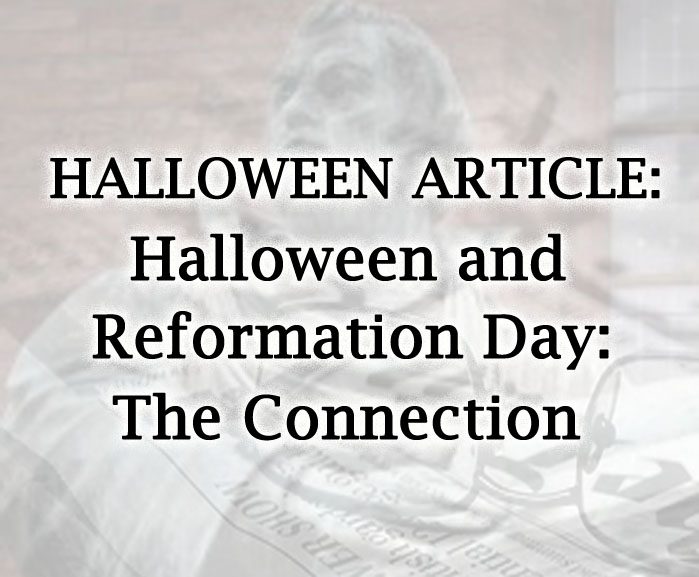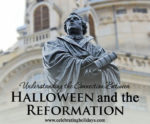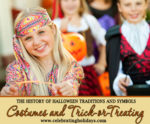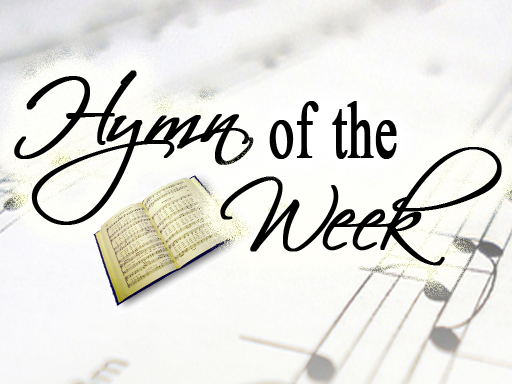Halloween History
Many sources mistakenly claim that Halloween has its origin in a pagan celebration called Samhain (pronounced sow-in). Though pagan ideas and various superstitions have certainly made their way into Halloween celebrations, the origin of the holiday is distinctly Christian.
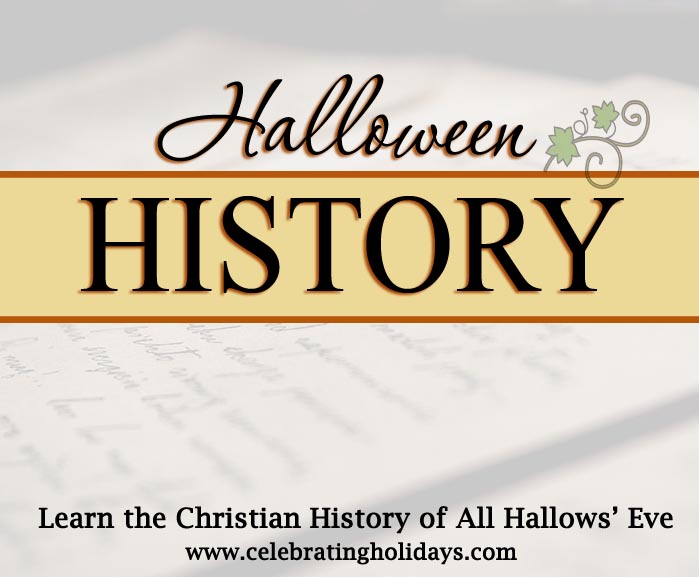
History of Halloween
The name Halloween is a blending of the words All Hallows’ Eve or Even (referring to the evening before All Saints’ Day on November 1). The term hallow means “holy” – you may recall reciting it in the Lord’s Prayer, “Our Father who art in heaven, hallowed be thy name” (Matthew 6:9).
From the early days of the church, saints (more specifically martyrs — the only persons initially recognized as saints) were honored and celebrated.1 However, with time, the growing number of martyrs (particularly under the persecution of Diocletian, the Roman Emperor from 284-305 AD) made it impossible to assign a separate celebration for each. Thus, various churches made an effort to select a common day to commemorate all the saints.

Pantheon in Rome (image from Wikimedia Commons)
Some churches celebrated on the Sunday after Pentecost, while others chose the Friday after Easter. In 609 AD (or possibly 610 AD), Pope Boniface IV dedicated the Pantheon in Rome to the saints on May 13, and he established it as a yearly celebration.2
Pope Gregory III (in office from 731-741 AD) is credited with choosing the date of November 1 when he dedicated a chapel in St. Peter’s Basilica, in Rome, to all the saints on that day and established it as an annual commemoration.
Later, Pope Gregory IV (in office from 827-844 AD) extended the holiday to all Christians by formally adding it to the Church calendar in 835 AD.3 By this time, Christians recognized as “saints” not only the martyrs but also the confessors (those who had “confessed” their faith by godly word and life but were not martyred).
It should be noted that the New Testament repeatedly uses the word saints to refer to all believers. However, early in church history, the term came to be used specifically for “heroes of the faith.”
History of Samhain (pronounced sow-in; “sow” rhymes with “cow”)
Many scholars claim that Gregory III chose to commemorate the saints on November 1 in order to combat an ancient pagan Celtic* festival called Samhain that was celebrated on the same day. However, Samhain seems to have been a tradition limited to the Northern Celtic people (particularly in Ireland and Scotland), and since these areas were Christianized by this time, it is difficult to substantiate this assertion. Furthermore, it should be noted that the Irish celebrated saints on April 20, “a chronology that contradicts the widely held view” that Rome adopted the November 1 date under Celtic influence.4 Lastly, if remnants of pagan practices remained only in the remote parts of Christian lands, they were probably not of particular concern to the Christian leadership in Rome. Scholar Francis X. Weiser believes that November 1 was chosen so that the many pilgrims who traveled to Rome for the Feast “could be fed more easily after the harvest than in the spring.”5
Samhain is a name derived from Old Irish that roughly means “summer’s end.”6 Practically speaking, it was a time to prepare for the harvest, shelter (and slaughter) animals, welcome home soldiers and kings, and generally reorganize communities in preparation for the coming cold weather.
Whatever claims are made about the ancient pagan celebration of Samhain are purely speculative. There were no written records among the northern Celtic people prior to their Christianization in the 5th century. Early Roman sources from the first century BC note the superstitious nature of the Celts and how they would celebrate their festivals with fire and sacrifices (both animal and human), but there is no specific mention of Samhain.
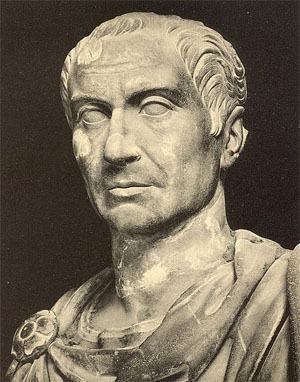
Julius Caesar (100 BC – 44 BC), Image from Wikimedia Commons
“The Gauls [Celts] are extremely superstitious.” (Julius Caesar, 100 BC to 44 BC, The Conquest of Gaul)
In order to learn anything about Samhain, we are forced to rely on northern Celtic folklore recorded in the 10th century and later. From this literature, we learn that Samhain “marked the boundary between summer and winter, light and darkness.” 7 This change of season lent itself well to colorful storytelling as the increasingly long and cold nights drew people around their hearth fires. Samhain served as the perfect setting for fairies, elves and spirits to appear in stories; it was also the time of year that mythic kings and heroes were said to have died.
However, there is no indication that ancient Samhain was ever a festival of the dead or dedicated to some Lord of the Dead. Though this idea was popularized by Sir James Frazer in his famous work The Golden Bough, A Study in Magic and Religion (1890), Frazer seems to confuse the traditions associated with All Souls’ Day (November 2) with ancient Samhain practices.8
Ironically, it was probably the Christian focus on the dead, combined with the change of seasons, which contributed to the growing Halloween lore about ghosts, goblins and creatures of the night. Now it comes as no surprise that nonbelievers would associate a holiday for the dead with darkness, mystery and fear. However, even among Christians, there developed a host of wild and terrible descriptions about the afterlife – particularly regarding the “punishments, torments and pains” of purgatory.9 Such beliefs, namely the connection between purgatory and indulgences, are what motivated Martin Luther to post his famous 95 Theses to the door of All Saints’ Church on October 31, 1517. The date was not coincidental. For more information on the association between Halloween and Reformation Day see our Halloween and Reformation Day page.
Halloween in America
The Reformation put an end to the celebration of All Saints’ Day in some parts of Europe, as well as in many of the early American colonies. However, Lutherans and Anglicans continued to recognize the feast (though with a more reformed theology), as did Catholics, and these groups brought their traditions to various places throughout the New World. Furthermore, a variety of regions incorporated elements of Halloween into their harvest festivals, even if they did not formally recognize All Saints’ Day. However, there was certainly no uniformity in how Halloween and the overall harvest season were celebrated in America. According to historian Lesley Pratt Bannatyne, “The existence of [Halloween], or of any autumn holiday, depended entirely on the religious and folk fabric of each emerging colony.”10
However, in the 1800s (particularly 1825-1845), America received a vast number of Irish immigrants who contributed significantly to forming an “American Halloween.” According to Bannatyne, “Of all the immigrant groups to enter America, the Irish had the greatest influence on the celebration of Halloween. They came in such great numbers that the cities and regions in which they settled took on new character, new ethnicity and, in many cases, a new holiday.”11
For more information, you can find useful articles on our Halloween Articles page.
You can also order a great 14-page pamphlet on “The Christian Origins of Halloween” — available at Amazon.com or Etsy.com. The pamphlet addresses many common questions about Halloween, including its symbols and traditions.
This page was created by:

We welcome your ideas! If you have suggestions on how to improve this page, please contact us.
The content on this page is drawn from a Rose Publishing pamphlet, Christian Origins of Halloween; it has a copyright © 2012. You may freely use this content if you cite the source and/or link back to this page.
Sources:
1 Thurston, Herbert. Notes on “November 1: All Saints” in Butler’s Lives of the Saints, Vol IV. New York: P.J. Kennedy & Sons, 1956, p.234. It should be noted that the New Testament repeatedly refers to all believers as “saints.”
2 Mershman, Francis. “All Saints’ Day.” The Catholic Encyclopedia. Vol. 1. New York: Robert Appleton Company, 1907. Sept. 2011. http://www.newadvent.org/cathen/01315a.htm.
3 Ibid.
4 Rogers, Nicholas. Halloween, From Pagan Ritual to Party Night. Oxford University Press, 2002, p. 22.
5 Weiser, Francis X. Handbook of Christian Feasts and Customs. Deus Books, 1963 (original 1952), p. 188.
6 Rogers, Nicholas, p. 11.
7 Ibid, p. 21.
8 Ibid, p. 19.
9 Aquinas, Thomas. Summa Theologica. Question 2, Articles 2 and 6.
10 Bannatyne, Lesley Pratt. Halloween, An American Holiday, an American History. Pelican Publishing Company, 1998 (originally published with Facts on File in 1990), p. 21.
11 Ibid, p. 66.
*The Celtic people are associated with the region of Western Europe called Gaul by the Romans. The people of Gaul migrated over time as far east as Asia Minor (recall that the Apostle Paul wrote a letter to the Galatians) and as far North as Ireland (where the term gaelic and its related term celtic are still used to describe ancient language and culture).
